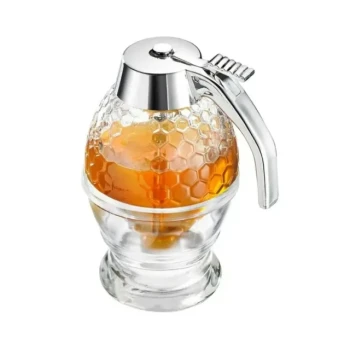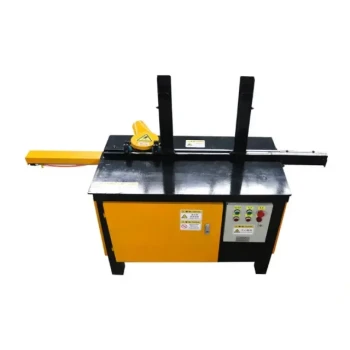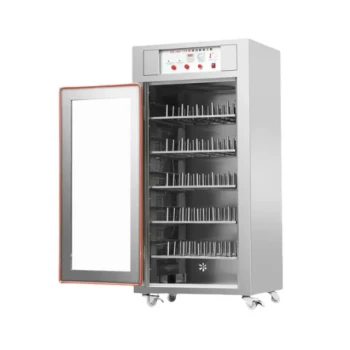Yes, you absolutely can dehumidify honey. This process is a critical step for beekeepers to ensure the long-term stability of their harvest. It is most effectively done by placing the frames of honey (the supers) in a small, warm room with a dehumidifier and a fan to circulate the air, which removes excess moisture before the honey is ever extracted from the comb.
The core issue is that honey with a moisture content above 18.6% is at risk of fermenting. Dehumidifying is simply a controlled process of evaporation to lower that water content to a safe level, effectively "ripening" the honey after it has been removed from the hive.
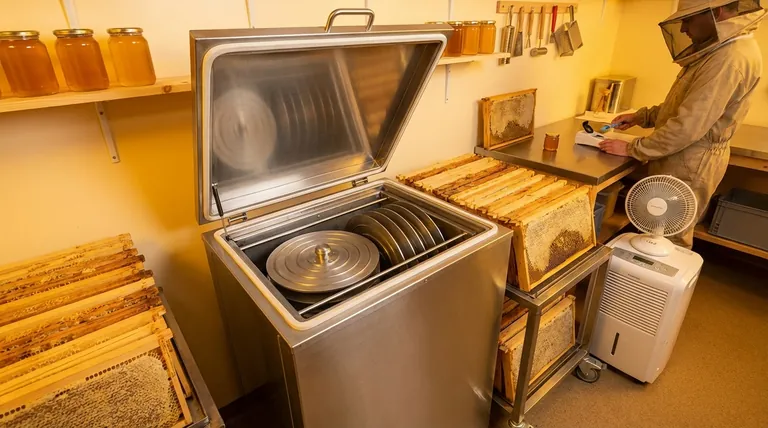
Why Dehumidifying Honey is Necessary
The Problem of "Unripe" Honey
Nectar collected by bees can be up to 80% water. Through a process of adding enzymes and fanning their wings, bees evaporate this water until the moisture content drops to a stable level, typically between 17% and 18.6%.
When this process is complete, they seal the honeycomb cell with a beeswax capping. Honey harvested from uncapped or partially capped cells is considered "unripe" and contains too much water.
The Fermentation Threshold
Honey contains naturally occurring osmophilic yeasts. In low-moisture environments, these yeasts remain dormant. However, once the water content rises above roughly 18.6%, these yeasts can become active and begin to ferment the sugars in the honey.
This fermentation spoils the honey, giving it a sour, "off" taste and a frothy appearance. The goal of dehumidifying is to bring the moisture content safely below this critical threshold.
The Principles of Effective Dehumidification
The most effective method for removing excess water from honey relies on controlling three key environmental factors before extraction.
Principle 1: Low Humidity
The fundamental driver of this process is creating an environment where the air is drier than the honey. A standard home dehumidifier is the essential tool for this. It pulls moisture out of the air, creating a "dry" atmosphere that encourages water to evaporate from the honey.
Principle 2: Gentle Warmth
Warmer air can hold more moisture, which accelerates the rate of evaporation. Gently warming the drying room to between 80-95°F (27-35°C) will significantly speed up the process.
It is crucial to use a safe, low-intensity heat source and avoid "cooking" the honey, as excessive heat will destroy its delicate enzymes and aromas.
Principle 3: Constant Air Circulation
A simple fan is non-negotiable. As water evaporates from the honey, it creates a small zone of humid air directly above the comb. Air circulation moves this saturated air away and replaces it with drier air from the room, maintaining a constant state of evaporation.
Understanding the Trade-offs and Pitfalls
Do Not Dehumidify After Extraction
Attempting to dehumidify honey after it has been extracted and placed in a bucket is extremely inefficient. The process relies on surface area, and in a large container, only the very top layer of honey is exposed to the air. The vast majority of the honey beneath will remain unchanged.
Always treat the honey while it is still in the comb, where thousands of open cells provide a massive surface area for evaporation.
The Danger of Overheating
The goal is warmth, not heat. Temperatures above 104°F (40°C) can begin to degrade the beneficial enzymes, like diastase and invertase, and can alter the honey's delicate flavor profile. Use a thermostat to maintain a stable, gentle warmth.
The Need for Measurement
You cannot determine moisture content by sight alone. The only way to know if your honey is safe is to measure it. A honey refractometer is an essential and inexpensive tool that provides an instant, accurate reading of the moisture percentage.
Making the Right Choice for Your Goal
To put this into practice, create a temporary or permanent "drying room"—a small, sealable space where you can control the environment around your honey supers.
- If your primary focus is a small, hobbyist harvest: A spare bathroom or a large closet works perfectly. Place a dehumidifier and a simple box fan inside with your supers, seal the door, and run them for 24-48 hours.
- If you are managing a larger operation: A dedicated, insulated warm room with a commercial-grade dehumidifier is a worthwhile investment for achieving consistent, high-quality results.
- If your primary focus is quality assurance: Use a refractometer to test a sample of honey before you begin and check it every 12-24 hours until you reach your target moisture level, ideally below 18.6%.
By mastering this simple environmental control, you can guarantee the quality and shelf-life of every honey harvest.
Summary Table:
| Factor | Purpose | Tool/Setting |
|---|---|---|
| Low Humidity | Creates a dry environment for evaporation | Dehumidifier |
| Gentle Warmth | Speeds up evaporation without damaging honey | Thermostat (80-95°F / 27-35°C) |
| Air Circulation | Moves humid air away from the honey surface | Fan |
| Measurement | Verifies honey is safe from fermentation | Honey Refractometer (Target: <18.6%) |
Ensure the Quality of Your Harvest with Professional-Grade Equipment
Perfecting your honey dehumidification process requires reliable equipment. HONESTBEE supplies commercial apiaries and beekeeping equipment distributors with the high-quality, wholesale-focused tools needed for success.
We provide the essential gear for professional honey processing:
- Commercial Dehumidifiers for creating the ideal dry environment.
- Durable Fans for consistent air circulation.
- Precise Refractometers for accurate moisture measurement.
Let us help you build a more efficient and profitable operation. Contact HONESTBEE today to discuss your equipment needs and request a wholesale quote.
Visual Guide
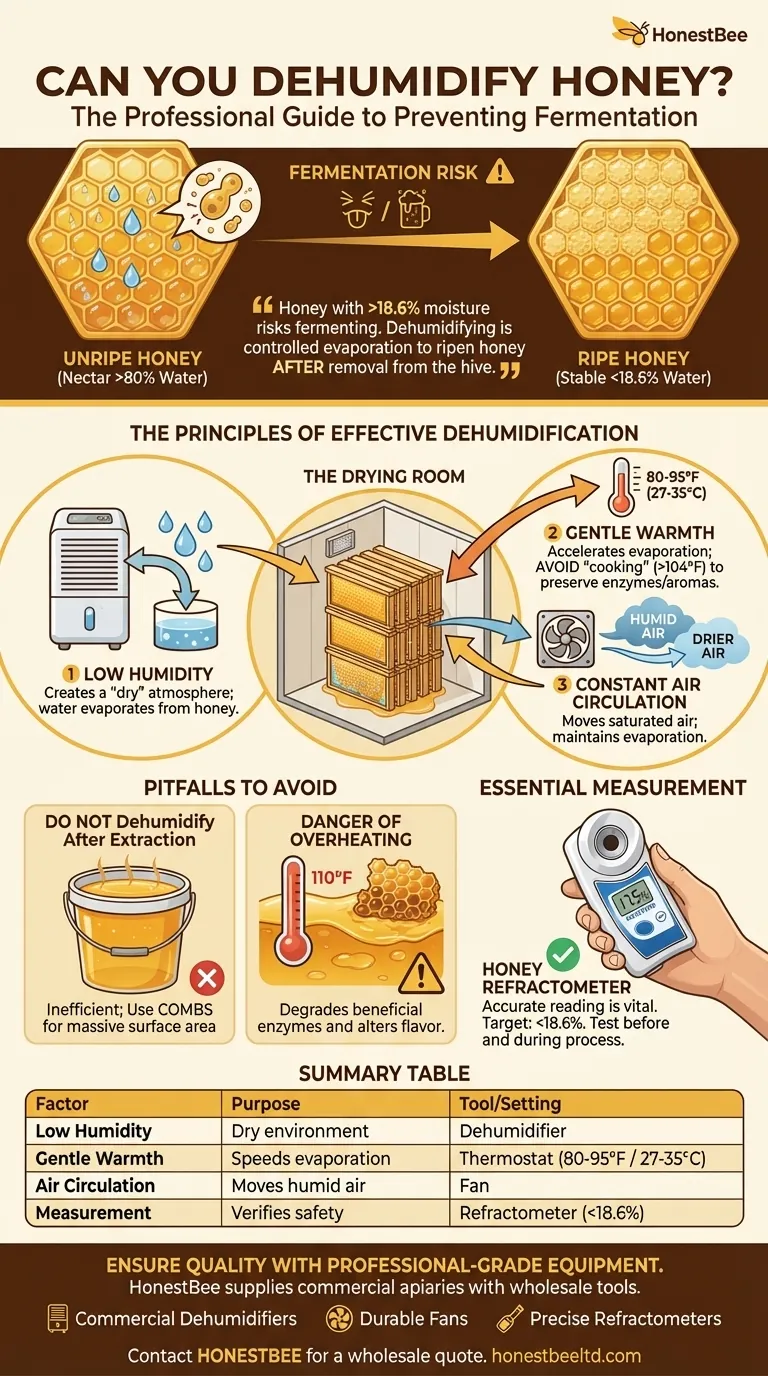
Related Products
- Economy Small Scale Honey Dryer Dehumidifier Thickening Machine
- High Quality Honey Dehumidifier Dryer Thickening Machine for Beekeeping
- Professional Thermostatic Conical Honey Melter
- Honeycomb Style Drip Free Honey Dispenser
- Honey Concentrating Vacuum Heating Thickening Machine Dehumidifier for Honey
People Also Ask
- What are the advantages of a condensation honey dryer? Boost Quality & Yield for Your Apiary
- How does a honey dryer remove moisture from honey? Achieve Perfect Honey Stability with Controlled Drying
- How to reduce moisture level in honey? Preserve Quality and Prevent Fermentation
- What are some methods to prevent fermentation in high-moisture honey? Protect Your Honey's Quality and Value
- How to remove humidity from honey? Protect Your Harvest from Fermentation



